| Report Type | Full |
| Peak(s) |
Snowmass Mountain - 14,105 feet |
| Date Posted | 05/29/2024 |
| Date Climbed | 05/05/2024 |
| Author | hokiehead |
| Additional Members | benopp, zgilbert |
| Snowmass Mountain East Slopes ski attempt in Spring |
|---|
|
Snowmass Mountain East Slopes ski attempt in Spring I can't cite the source, but years ago I read a piece that suggested the best moment of a summit attempt is not when you reach the top, but rather the point where you know you're going to make it -- that nothing short of an act of God is going to prevent you from summiting. Sometimes that moment happens a mile after leaving the TH -- I'm feeling strong, weather looks good and I know what's in front of me is well within my abilities. Sometimes that moment happens a few feet from the summit -- this was the latter. Dates: 04 - 06 May 2024 Crew and background: @hokiehead (Troy), @zgilbert (Zach) and @benopp (Ben) Zach and Ben are far more experienced skiers than I. This was my third season as a skier (I literally put on ski boots at a resort for the first time November 2021) and my backcountry ski mountaineering experience was limited to Quandary and Sherman. I thought Snowmass would be a good next step. It wasn't a horrible thought, but the adventure turned more challenging than anticipated. I had summited multiple 14ers and 13ers with each partner, including a ski 14er as well as overnights in the backcountry with each, but this would be the first time Ben and Zach met and the first ski mountaineering adventure that included a night in the backcountry for any of us. I had researched the route (read multiple trip reports, route description on 14ers.com, Roach, Dawson) and was confident this was a hard, but realistic, goal -- which turned out to be correct. Zach and Ben also made significant contributions to this TR. Plan: · Sat: hike and skin to Snowmass Lake (8 miles, 2600'), set up camp · Sun: summit (7 miles, 3000'), ski down, return to camp · Mon: break camp and ski/skin/hike back to TH (8 mi, -2600') (We left the option open of possibly breaking camp and heading out on after the summit on Sunday. Inwardly, I really wanted that to happen.) Weather forecast: I wish I had taken screenshots, but the weather report at Snowmass Lake showed mild temperatures with occasional flurries on Sat, windy with temps down to 20F on Sun, and a chance for a few inches of snow on Monday. No recent condition reports were found on any of the 14er fora. Saturday: uneventful drive to the TH where we started around 10AM in hiking boots, with skis A-framed to our already heavy packs. We hiked for about 4 miles before transitioning to skins. The relief from getting the weight of the skis and boots off my back to being useful on my feet was incredible. One pair of (faster) mountaineers passed us headed to the lake as we were transitioning to skins and discussing whether we'd have continuous snow from there. We set our radios to the same channel as that other pair, and they confirmed 15 minutes later that conditions were good to skin from where we were. Mostly true, but we had to remove our skis twice for short distances. We passed two other pairs of skiers heading out -- one had skied Snowmass from the ridge and the other had skied Haggerman. Other than the packs wearing on us, the trip in experienced a squall moving through that dumped a bit of snow and caused conditions to be less pleasant for a short while, but nothing that was going to turn us around that this point. 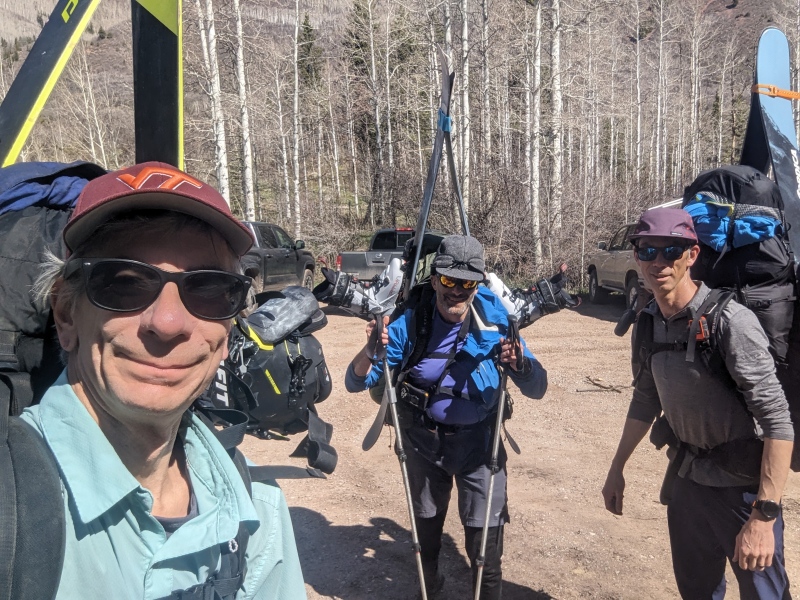
Nine hours to get to the lake and choose a camping spot. We scouted the area for a bit and chose a spot mostly surrounded by trees, which likely offered us some shelter over the next days. There was one other campsite occupied by the pair who overtook us on the approach, otherwise we had the lake to ourselves. The ground was covered in deep snow, and the realization hit me that any departure from our camp (e.g. filtering water) would require skis -- that made this outing feel even more mountaineery. We setup tents, filtered water, cooked dinner, ate, brushed teeth and went to bed, agreeing to a late'ish start of 6AM. 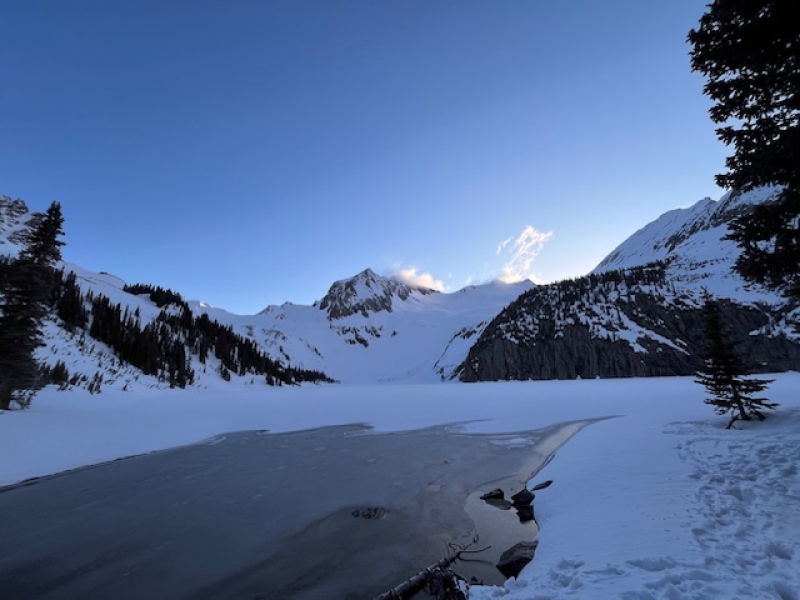
The weight of the pack had really beat me down (it was 65lbs with skis and AT boots strapped on). As I was falling asleep, I put the odds of making the summit at 50/50. My training had prepared me for the miles and the elevation and the altitude, but not the weight of that ****ing pack. Sunday: I woke up feeling fairly refreshed, and I was slightly more optimistic for the summit. Hot breakfast and coffee, then filter water again and start skinning across the lake to the base of Snowmass Mountain. Zach’s first comment that morning was “’wind’ is the word of the day”. Yeah. 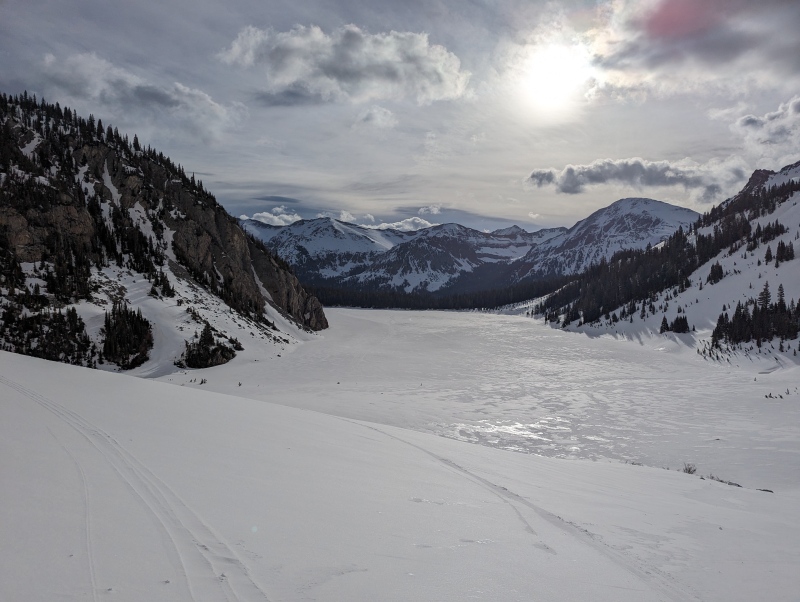
The pack felt so light without all the overnight gear and my encouragement increased. Windy conditions persisted most of the day, but not to the point of being miserable. We made it on skins to somewhere around 12k - 12.5k' before putting ski crampons on. The other pair of skiers had started earlier and we saw them returning from the summit on skis as we were donning our ski crampons. They said they booted it from the ridge but were able to ski from the summit. The day also offered me a chance to use a wag bag while on skis -- now I felt like a REAL ski mountaineer! 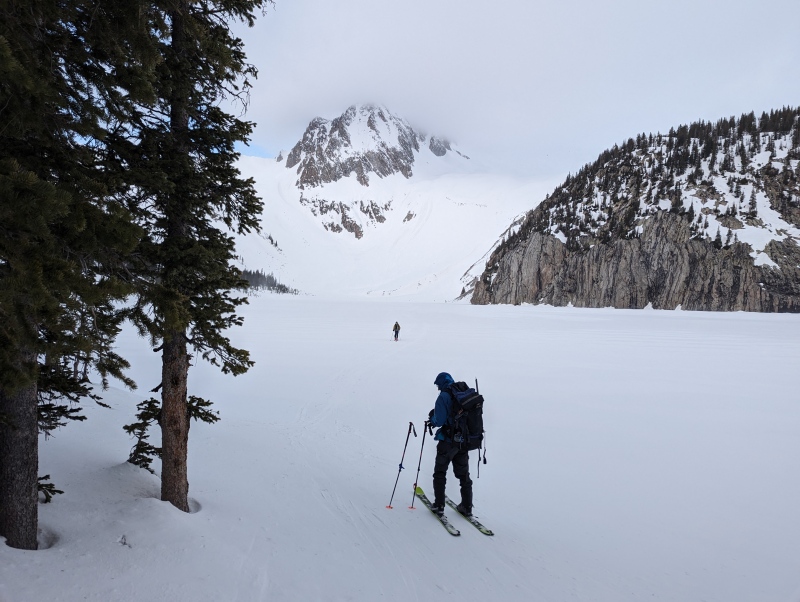


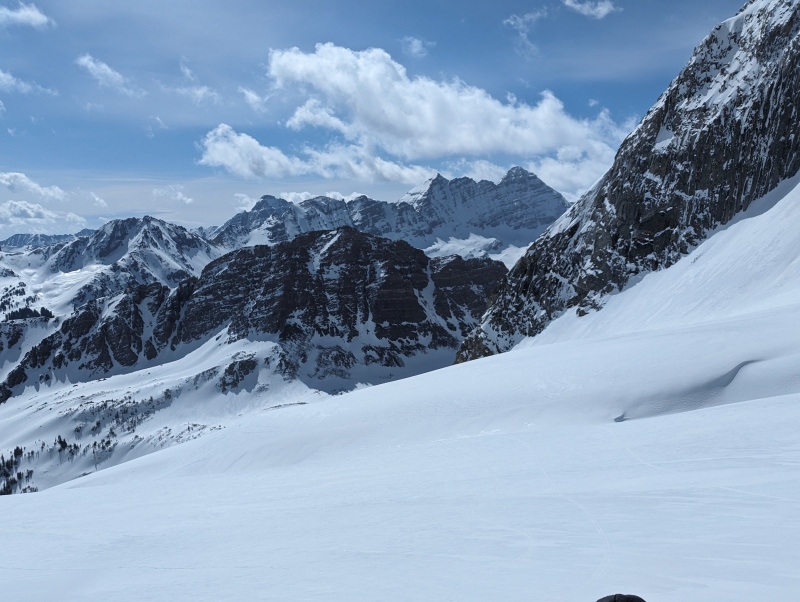
We used ski crampons to maybe 50' of the ridge, where we switched to boot crampons (over our AT boots - we had left hiking boots at camp), A-framing our skis again and carrying them up (groan). Gained the ridge and agreed we wouldn't try to ski from the summit -- none of us felt confident in what we saw with my AIARE trained partners noting a wind slab avy problem on our likely descent route. We decided to ditch our skis and packs there to move light and fast to the summit (maybe 1/3 mile and 300'). From there it was boot crampons and ice axes. Often on steep snow, sometimes on bare rock -- I guess that's "mixed climbing". 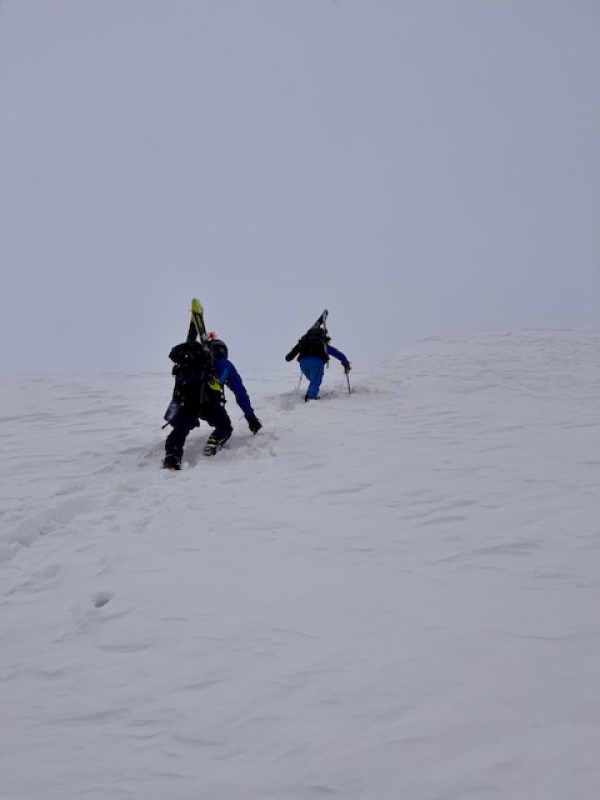

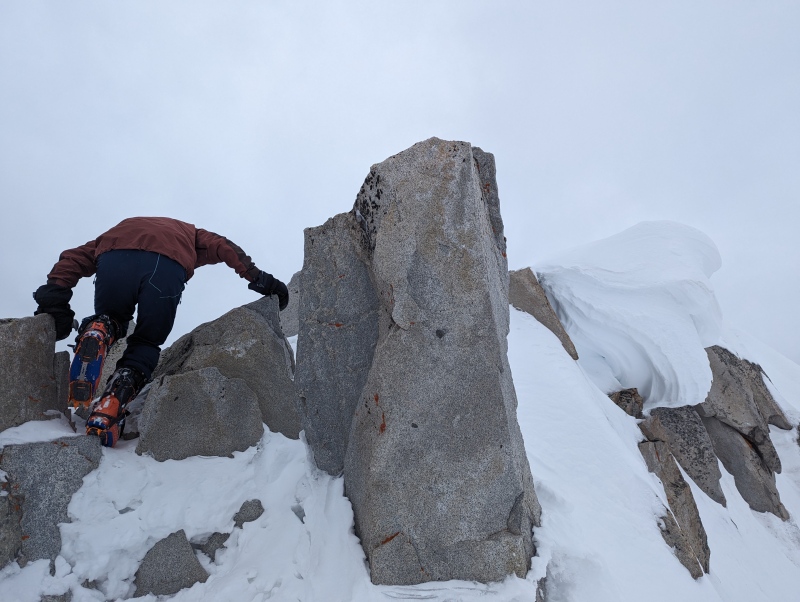
We made the summit without incident, grabbed some pictures and decided not to linger. 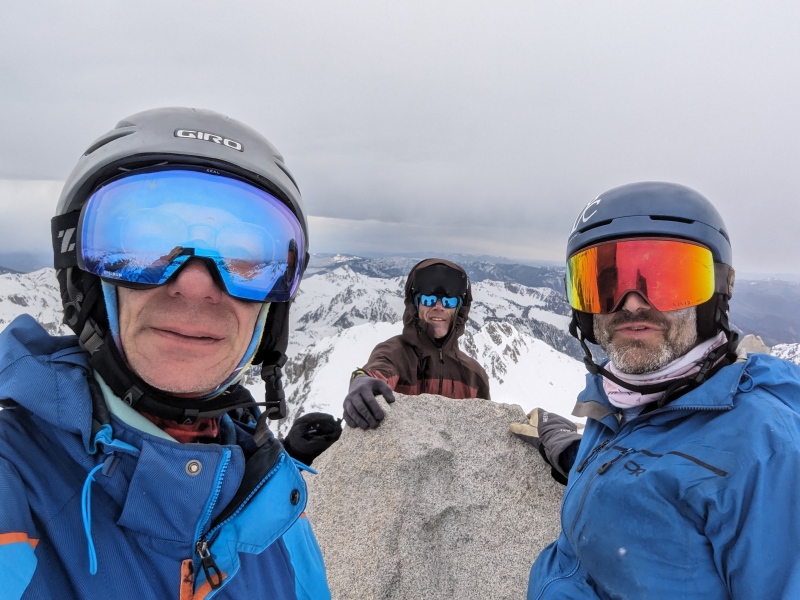
On a section of steep snow going back to our gear, with boot crampons on our feet and ice axes in hand, Ben slipped and slid about 10' before executing a textbook self-arrest with his axe. Apparently the YouTube video he watched years earlier impressed the technique in him. Returning to our gear stash where we gained the ridge, we were excited for the ski down (from somewhere around 13,600’). The skies had been overcast for a few hours though, so no corn to be had. I really had no idea what I was facing, but would soon learn the term "breakable crust" and its associated hazards. I suggested that I go first, as I was the weakest skier and was comforted by the idea that my more experienced partners could possibly ski down to me if I needed assistance (we’ll revisit that decision below in “lessons learned”). After discussion, we had decided to ski with ice axes in hand, a first for all of us (fortunately we never needed to arrest). I pointed to a large boulder as the rendezvous spot, we made sure our radios were on, and off I went. And down I went…. while trying to execute the very first turn. Wow, what happened? Was it the large pack throwing me off balance? Are my legs fatigued? Did I forget how to ski? Not sure. I got up, became slightly more cautious and executed a few turns before another fall. Ben would later describe the conditions that "every fall on this snow is a bad fall". Yeah. I fell several times and one in particular was really bad, sending me cartwheeling upside down, resulting in my left ski getting planted vertically and my body torqued clockwise - leading to what I'd later learn is a torn meniscus. I knew something bad had happened, but I was able to get back up and wasn't in a lot of pain. Zach and Ben had similar difficulties getting down, falling multiple times; fortunately, neither of them were injured. What I believe was happening, is that when the skies clouded over, a hard, 4-6” crust had formed over otherwise soft and slightly slushy snow. When we'd try to make a turn, our edges would cut through the crust and our skis would sink fast and continue forward in a straight line through the soft snow underneath, the heavy crust holding our ski under the surface making extraction very difficult. 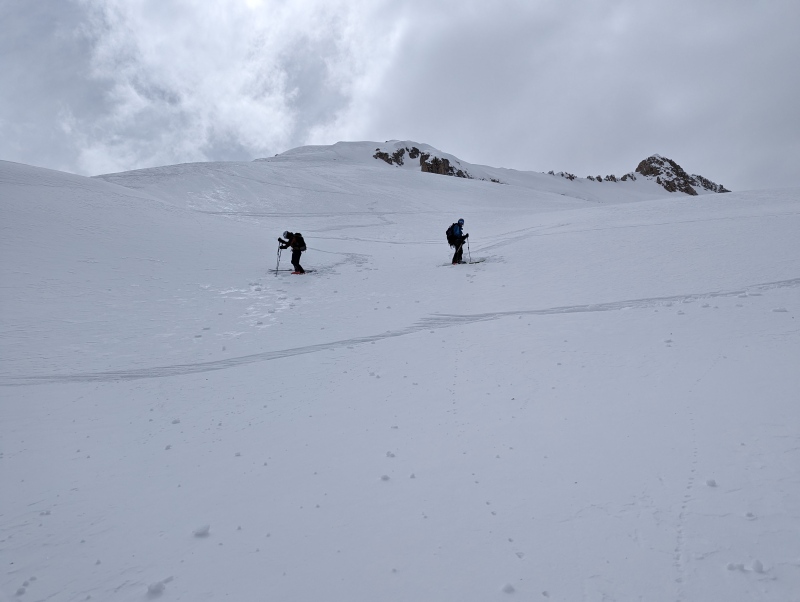
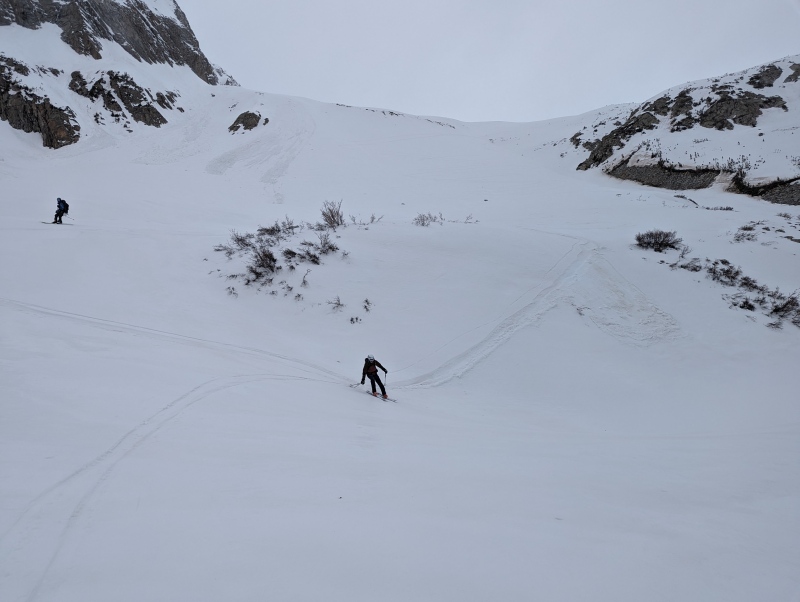
There were two points during this adventure that I felt stressed -- having to ski down 2600' of the worst snow conditions I'd ever encountered with an injured knee was the first. What was supposed to be the best – the most fun -- part of the adventure turned into something scary. The view from 13,600’ down to the lake conjured fear similar to the first time I stared down a blue run as a novice skier. Most of the remaining descent was terrible, slow and fatiguing, with me in a wedge formation looking like a beginning skier most of the way. About 500’ above the lake, conditions improved to where we could relax and ski somewhat normally. We got back to camp and agreed none of us were up for trekking 8 miles back to the TH; we'd spend another night in the back country. I was worried about my knee -- it was wobbly and definitely not at full strength and I was concerned it would swell a lot overnight making it difficult to get back to the TH. We filtered water, cooked dinner, ate and settled in the tent, only for me to create a new problem. As I was removing my AT boots, I broke the tongue on the left, meaning I'd have far less stability for the trek out (and this was the same left side where I damaged my knee). Ok, a new challenge to overcome – this is what mountaineers deal with, right? 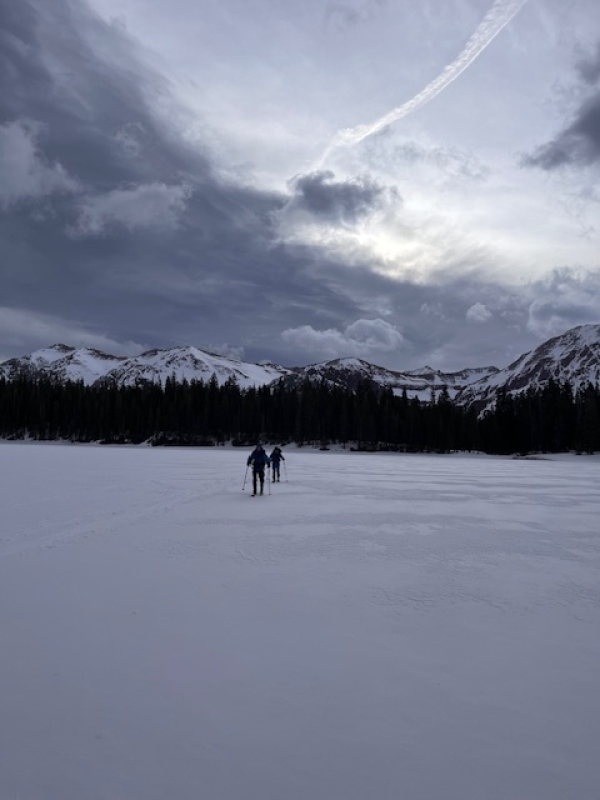
Sunday night: We had about 18" of fresh snow dumped on us. All of us being in 3 season tents had trouble with our sections of the tent sagging and even collapsing. Every time I woke up, I remember thinking "breaking camp is going to suck" while mentally going through all the tasks we'd need to do in a snow storm. Zach and Ben later shared they were going through the same thoughts. 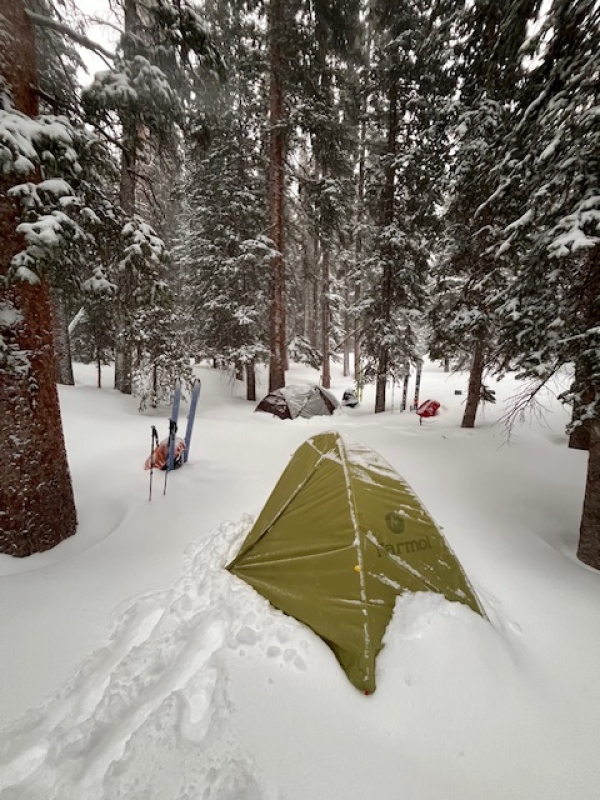
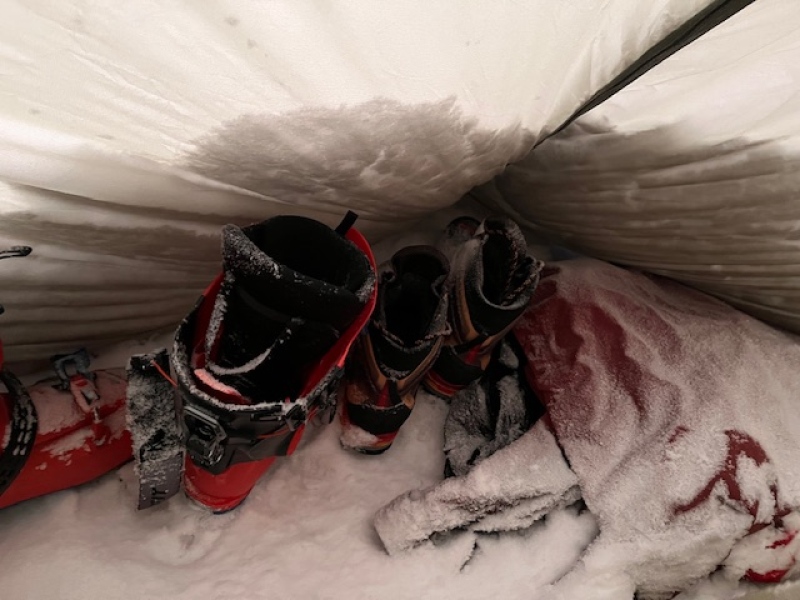
Monday: It was still snowing hard the next morning as we packed up. This contributed to a less than optimal packing in my backpack, but I eventually got everything stored and secured, ate a power bar (no hot breakfast) and we headed out on skins. I had worn my liner gloves while packing up gear and they were now soaked. Actually, *everything* was wet. However, the wet liner gloves seemed better than nothing (we'll come back to that point) and it didn't feel cold enough for my mittens, so I wore the damp liner gloves on my hands for the first few hours of our trip out. My knee was weak and unstable (I couldn't push up with my knee weighted to stand up from the tent on my own – Ben had to give me an assist), but it was not swollen and as long as I kept it straight (ie. no rotation), I could move fairly well walking or skinning. OK, that’s good. 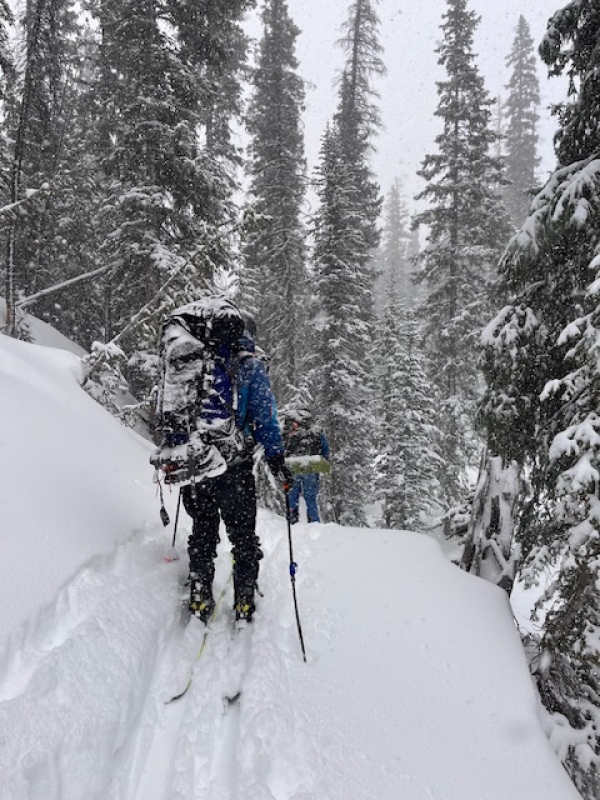
Navigation was very difficult. The tracks we followed (and the one's we created) coming in two days earlier were now covered, and the heavy snowfall had filled in many of the gaps between trees and shrubs, making finding the route a real challenge even with GPS tools. A few times we doubled back and tried multiple ways to get through an area before finding one that worked – the longest “problem” to solve took us about 45 minutes of trying multiple routes. The second time I felt stressed was during our trek out when we had navigation challenges and the heavy packs were seemingly weighing ever more. This was supposed to be the easy part! We finally ran out of continuous snow coverage and decided to pack our skis and change to hiking boots for the last 3 - 4 miles. The fresh snow allowed us to ski out maybe ½ mile further than where we transitioned on the approach and the remaining “boot” miles did include some postholing. It was cold, but not exceptionally cold at this point, maybe low 20's, possibly in the 10's. I was struggling with the transition, especially manipulating my too heavy pack while trying to attach my skis. I remember getting frustrated working through challenges with this transition, and ended up working bare handed for maybe 15 minutes. The snow was still falling and everything was still wet. My hands got very cold, but not painfully cold and not red to the point it caught my attention. When I finally finished transitioning, I shoved my hands into my good mittens and started hiking. I had just eaten as well during that transition and was soon warming up. I flexed my fingers inside my mittens and they seemed to be warming up with no issues, except some tingling. I don't recall the last time the sight of the vehicle in the TH parking lot was so welcoming. I was deliberately not looking at my navigation device for the last stretch, and thought we had another 1/2 mile or so. Seeing Zach's F150 when we came around the last bend in the trail was ecstasy, and I am definitely not a Ford guy. Really appreciated that Zach had parked in the spot as close to the TH as possible. Aftermath: my fingers were tingling and numb well after we got back to the car and ate. I wasn't sure what was going on. Four days later the tips of my fingers (and even later my toes) turned black and I would learn that I had gotten frost bite on all ten fingers and four toes. I saw a dermatologist who explained that over the next several weeks those areas would rot and fall off and create open wounds. Well, awesome. I'm to follow up w/ my PCP for wound care. Fun. My wife has been taking home medicinal courses and my frostbite gave her a project to apply that knowledge -- I've been using an herbal oil as well as a tincture she made. So far two fingers where the skin died and peeled off had closed skin underneath and did not create an open wound. Hoping that's a sign for the other digits, but realistically, my right big toe isn't feeling great. My feet are not exactly pretty and now have black rotting flesh at the ends of my toes -- I may not spend much time barefoot in public this summer. I am still hoping that issues with my fingers don't ruin summer rock climbing season. Tangent, but I also learned that dermatologists don't frequently deal with frostbite; usually patients seek ER/urgent care initially and then follow up with a wound specialist. After a week of my knee not noticeably improving, I saw an orthopedist, who suspects a torn meniscus, but no torn ligaments. MRI to follow and confirm. If I need surgery on that though, it's ~2 months to recover, so the summer 14er season won't be totally lost. Swelling is down and I can walk without a limp, but I'm not sure when I'll be running and strength training again. I am really grateful neither of my partners suffered injury. I initially took my Dynafit Radical AT boots back to Bentgate in Golden where I had purchased them, asking if the one with the broken tongue could be repaired. "No" was the answer from the employee after he consulted with the bootfitter on duty. ****! And the warranty was past.... by two months. ****, ****, ****ity ****!!! I was really hoping to get more than two years out of those, never mind I have a long list of expensive outdoor gear I wish to procure that would now get de-prioritized with me dropping big bucks on new AT boots (mentally planning future spousal negotiations over the family budget for my recreational gear). I messaged Dynafit asking if they could help, but didn't get a response. So, I reserved another pair of Radicals at Bentgate and made a boot fitting appointment for a few days later. When I showed up for the bootfitting, I brought my old boots in and asked John if the custom footbeds could be re-used. He looked at the boots and asked why I was replacing what looked like fairly new boots. I showed him the broken tongue. "That's an easily replaceable part. Have you contacted Dynafit?" I had, but not through his recommend channel and not asking the right questions. A week later, Dynafit mailed me a pair of replacement tongues at no charge. Awesome. Zach and I have gotten into a routine of debriefing after a backcountry outing. What decisions would we make differently? what did we bring that we didn't use? what did we do right? etc... For the most part, we were happy with our decisions, but after learning I had frost bite, I amended that. Also, I note the best decision I made was picking the right partners. Lessons learned - my sincere hope is that at least one person can benefit from my mistakes. Dry footwear: Knowing I had a 3 season tent, I should have put both ski and hiking boots in the tent on Sunday night (vs the vestibule which collapsed). Also, when we started on skis, my hiking boots were strapped to the exterior of my pack, getting more snow inside. I made efforts to shake out the snow before putting on boots (AT boots in the AM and then hiking boots at the transition), but could've done more to keep them dry in the first place. Glove and mitten management: I had three pairs with me -- liner gloves, medium gloves and heavy mittens. (A) I wasn't thinking clearly when I packed away my medium gloves, deep in my big pack, believing the liner gloves and mittens would be sufficient. If I had the medium gloves I could've done some of the transition activities with those, exposing my hands to the cold and wet for less time. Also, just having a third option to rotate and try to keep dry would have been helpful. (B) I wore my liner gloves that morning packing up camp and they got soaked. I wore only those during the initial skin out and didn't feel cold, but now realize the wet was conducting heat away more than I knew. (C) the inside of my good mittens got snow in them during times when I had them off. I could've done a better job keeping them dry. (D) I had chemical handwarmer packs that I wasn't using on that day. Practice manipulating gear, including doing so with gloves and mittens: My transtion took too long -- I should've been more efficient at securing skis to my pack and other tasks that led to me working bare handed for so long. I could've taken breaks and warmed up my hands, but in frustration I "gave up" too early and went bare handed instead of trying some tasks with mittens and only those requiring more dexterity with bare hands. Note that I’m still a new ski mountaineer; I had practiced the A-frame exactly once in my living room before this trip. I honestly wish I had done it 6 – 8 times, while wearing gloves and mittens, in the shower with the water running (ok, maybe not that last part, but actually, maybe so). It seems really simple to A-frame skis with Voile straps until I had to do it in shitty weather with an unwieldy pack. Also, I need to be practicing breaking camp and packing up to make the routine more standard and efficient. These don’t seem like very “sexy” training sessions but likely would’ve made a big difference. Lighten the pack: not directly a cause of my issues, but an exacerbating factor, was the weight of my pack. I used everything I brought besides emergency gear and microspikes, but I really need to invest in lighter stuff. 60+ pounds is too much for a trip like that, at least for this guy. A significant part of my challenges during that last transition was my too-heavy pack. I since started the project of weighing all my gear and augmenting my backcountry packing list with the associated weights -- the first step towards improving the situation is measuring current state. The other skiers we passed had notably smaller (and presumably lighter) packs. Three things to continue to look at here: 1. What did I take that I didn't need? Honestly, the list is small. Microspikes were the most obvious thing I should’ve left (redundant w/ boot crampons). I also need to go through my kit of first aid and essentials -- there's stuff in there I haven't used in 5+ years of climbing 14ers yet I still haul it all up every summit. I wore all my layers and I ate almost all my food. Still, the first place to optimize. 2. What did I take and use that I could possibly do without? This list may be smaller but requires some consideration. Bear canister is required in the Maroon/Snowmass Wilderness, but I'm not 100% it was necessary in early May. The stove could be left behind if everyone is willing to give up hot dinners (that’s a real tradeoff to consider). Is it possible I could've done all the hiking in my AT ski boots and left hiking boots behind (the thought doesn’t make me happy)? 3. What can I replace with smaller, lighter gear? My pack(s) and my sleeping bag are the first two on this list. Related tangent A: I could also train more with a weighted pack to increase my capacity for carrying loads, in an attempt to work the problem from both ends. Related tangent B: Lastly, if we were in slightly better shape, we could've safely planned on only one overnight and not needed the contingency food for the second night. Expect backcountry snow conditions and be more familiar with hazards of bad snow: Having no idea of the dangers of those snow conditions was where my lack of experience and knowledge led directly to the damaged knee. This was a painful and expensive lesson, but one I now know. And maybe I should have let the more experienced skiers go first to test the conditions. I don't think Snowmass was beyond my ski abilities, but that breakable crust made it a real challenge. We may have also benefited from waiting for the overcast skis to deepen the freeze – while we certainly didn’t want to delay our descent any more, that may have made a difference. Key takeaway: if I had known more about the hazards of these snow conditions, and weather conditions that make that snow more likely, that could have been avoided. Start summit day earlier: Zach is more knowledgeable than me about which weather conditions lead to what snow conditions. He suggested that if we had started a few hours earlier, we would've had our ski down Snowmass while the sun was still out and caught better snow conditions. Get more in tune with my body: my hands felt cold during that final transition, but not to the point where I thought I was in danger of frost bite. That was wrong. My feet never once felt cold and I was really surprised to end up with frostbite on my toes. This is a topic to take up with my doctor, and spend some time meditating on, but developing a closer relationship with my physical body needs to be a focus. Conclusion Ben summed it up well -- "everything was hard". No part of this was beyond our stamina or beyond our technical abilities, but every step pushed us hard and the total experience became the "biggest" mountaineering adventure I've had (Chicago Basin 14ers from Purgatory was a close a 2nd). Zach made the comment during dinner on the way home that "every future outing where things are not ideal will be compared with this one and I'll remember we made it through." While successfully making the summit of Snowmass, I found myself once again humbled by the mountains. Returning to the trailhead safely is the requirement, not achieving the summit. The mandatory part didn’t happen, and that left me with a lot to think about. That said, despite the aftermath, this was Type 2 fun. I’m glad I did it and I’m proud of where I am as a mountaineer. I am somewhat embarrassed at the frostbite and I certainly wish I had avoided the knee injury as well. Those two represent the worst injuries I’ve had since I started climbing the 14ers ten years ago. |
| Comments or Questions | |||||||||||||||||||||||||||
|---|---|---|---|---|---|---|---|---|---|---|---|---|---|---|---|---|---|---|---|---|---|---|---|---|---|---|---|
|
Caution: The information contained in this report may not be accurate and should not be the only resource used in preparation for your climb. Failure to have the necessary experience, physical conditioning, supplies or equipment can result in injury or death. 14ers.com and the author(s) of this report provide no warranties, either express or implied, that the information provided is accurate or reliable. By using the information provided, you agree to indemnify and hold harmless 14ers.com and the report author(s) with respect to any claims and demands against them, including any attorney fees and expenses. Please read the 14ers.com Safety and Disclaimer pages for more information.
Please respect private property: 14ers.com supports the rights of private landowners to determine how and by whom their land will be used. In Colorado, it is your responsibility to determine if land is private and to obtain the appropriate permission before entering the property.
